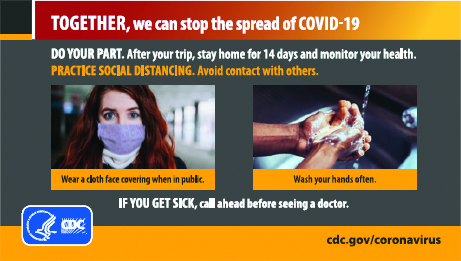Protecting health at our borders
Safe harbor from COVID-19’s tempests at sea

In early 2020, CDC and the US Coast Guard helped more than 260,000 people disembark from cruise ships that were threatened by COVID-19. The crisis started with infection spreading among passengers on a single cruise ship and led to the largest cluster of COVID-19 cases outside mainland China at that time.
- In March, COVID-19’s sudden spread on cruise ships led CDC to issue the first-ever industry-wide No Sail Order to keep the disease from spreading on the ships and into communities. In addition, CDC issued a Level 3 Travel Health Notice that warned all travelers to defer cruise travel worldwide based on widespread ongoing transmission of COVID-19.
- Since the crisis began, CDC and the Coast Guard have supported medical triage and evacuations for 41 cruise ships affected by COVID-19.
CDC continues working closely with cruise lines to develop public health guidance and preventive measures for the safe resumption of passenger travel on cruise ships.
Innovating and expanding to protect the United States from disease
The emergence of COVID-19 underscored the critical need to expand CDC’s quarantine and border activities to prevent the spread of disease. In the years ahead, NCEZID will innovate and expand programs that protect the United States from communicable disease, including
- Modernizing CDC’s quarantine station network through an integrated system involving international and domestic coverage of air, land, and sea points of entry.
- Increasing our capacity to work with cruise and cargo ships to better allow CDC to rapidly identify and respond to maritime public health risks.
- Expanding comprehensive traveler management systems to quickly provide travelers with essential information to contain infectious diseases before they spread.
A surge like no other: CDC screened a record-setting number of travelers at US airports

COVID-19 spread around the world at the speed of air travel, and to slow its entry into the United States, CDC screened a record number of international air passengers for symptoms of the disease. An estimated 766,044 people, arriving in the United States from 31 countries, went through the health checks at 15 airports.
CDC recruited and trained approximately 600 new staff for a surge to CDC’s 20 quarantine stations at the country’s borders and points of entry, where they and border agents helped identify infected travelers. CDC and state and local health departments found treatment for passengers who needed it.
CDC also posted travel health alerts (pictured above) on airport monitors and on postcards to warn people about the symptoms of COVID-19 and how to better prevent getting or spreading the disease
